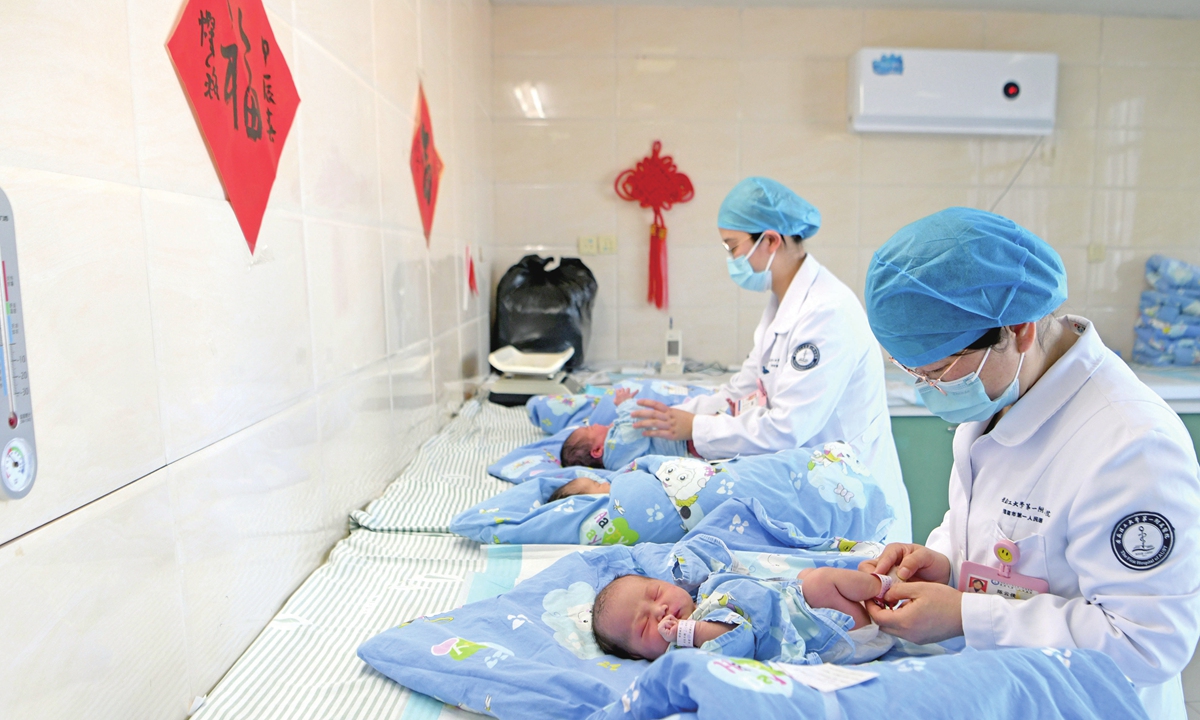China's NHC vows to protect mothers and children, improve service quality amid negative population growth challenges

Nurses take care of babies at the First Hospital of Anhui University of Science and Technology in Huainan, East China’s Anhui Province, on February 16, 2024. Photo: VCG
China's National Health Commission (NHC) vows to make an all-out effort to protect the safety and health of mothers and children amid the challenges faced by obstetrics departments nationwide due to China's negative population growth.
Affected by the "collapse in population," obstetrics departments with high risks, low performance, and lack of profitability have encountered increased difficulties. Caixin reported on Monday that some obstetrics departments in comprehensive hospitals across the country have been closed, accelerating the contraction of the nationwide obstetric service system.
According to Caixin, only a few grassroots hospitals stopped providing obstetric inpatient delivery services between 2020 and 2022. However, at least 15 hospitals ceased obstetric delivery services in 2023, and nearly 10 hospitals have announced the closure of obstetric services as of the end of the first quarter of 2024.
Regarding the development of the maternal and child health service system in light of the new population situation, the NHC responded in a written statement to Caixin, stating that the authority affirmed its commitment to strictly observing safety standards and making every effort to ensure the safety and health of mothers and children. This commitment comes at a critical time when China is actively promoting the establishment of a healthy nation and implementing optimized fertility policies. Despite the challenges facing the maternal and child health service system, the NHC remains dedicated to its mission.
According to the NHC, there are currently 3,082 maternal and child health care institutions, 793 maternity hospitals, and 151 children's hospitals across the country. Additionally, 3,491 critical maternity treatment centers and 3,221 neonatal intensive care centers have been established at the provincial, city, and county levels. Nationwide, these institutions employ 627,200 individuals, including 373,000 obstetricians and gynecologists and 205,800 pediatricians.
The NHC has designated midwifery services as a "basic medical service." To ensure the accessibility of this service, the NHC formulated and issued a notice at the end of March to strengthen the management of midwifery services. This directive was developed based on feedback from local health administrative departments, medical institutions, and industry experts.
The notice stated that public medical institutions should bear the responsibility of providing basic obstetric services. It also outlined specific requirements for strengthening midwifery services across six aspects. These requirements encompass strengthening the planning of midwifery services and ensuring the provision of services to effectively meet the needs of pregnant women. Additionally, the notice calls for proactive publication of the list of midwifery institutions and acceptance of public supervision, as well as the enhancement of the management of midwifery service quality. Furthermore, it emphasizes standardizing the adjustment of midwifery service resources to ensure accessibility.
In further explanation of the notice, the NHC emphasized that public medical institutions at all levels providing maternal health services should, in principle, ensure continuous obstetric services. If a public medical institution intends to close its obstetrics department, it should extensively solicit opinions from pregnant women with medical records and seek written opinions from local communities (local authority governments) and county-level health administrative departments.
The NHC stated that the authority will comprehensively assess the treatment system in 2024, enhance the capacity for treating critical and severe cases, and strictly adhere to safety standards. This is because the network for treating critically ill pregnant women and newborns serves as the last line of defense for ensuring maternal and infant safety.
Additionally, the construction of maternity-friendly hospitals will be initiated to enhance the comfort and satisfaction of pregnant women during hospitalization for delivery, thus improving their childbirth experience.
According to the NHC, the maternal mortality rate in 2023 was 15.1 in every 100,000 childbirths, the infant mortality rate was 4.5 in every 1,000 newborns, and the mortality rate for children under 5 years old was 6.2 in every 1,000 children. These figures represent a decrease of 10.7 percent, 16.7 percent, and 17.3 percent, respectively, compared to the figures in 2020.
The NHC also required that health administrative departments at all levels coordinate with relevant departments to establish support mechanisms that promote the high-quality development of obstetrics departments.
The commission added that public hospitals at all levels should strengthen their public welfare attributes, improve internal allocation systems, mobilize obstetric medical staff, and strive to ensure that the pay level of obstetric physicians in comprehensive hospitals is not lower than the average level of hospital physicians.
Furthermore, the NHC strictly prohibits issuing revenue generation targets to obstetrics departments and obstetric medical staff. The payment of obstetric medical staff must not be linked to revenue from pharmaceuticals, medical supplies, examinations, laboratory tests, or other services, the NHC said.
Global Times



